DIPPER DELIGHTS
by John J. Smith
Most of us in the mosquito control field have spent more time
than we care to think about wandering around wetlands sampling
for mosquito larvae with our trusty dippers. So many times we
see creatures that we have not seen before or are not able to
identify. I find the creatures which live in the aquatic environment
fascinating. It is almost as if you have been teleported onto
another planet inhabited by a totally unique assemblage of creatures
as foreign as those living at the bottom of any oceanic rift valley.
I am especially intrigued by the invertebrates such as the crustaceans,
annelids, insects and yes, you can even observe examples of the
sponges and hydras. I can remember as a kid spending most of my
time while supposedly skating, actually on my hands and knees
with my face inches from the transparent ice watching the caddisfly
larvae struggling with their cases as they traveled across the
submerged vegetation. I did not get much exercise but it did open
my eyes to the fact that life goes on even when the temperatures
drop and the snow flies.
 I
have often corrected people when they would say that there are
no mosquitoes around in the middle of winter when in fact there
are millions of mosquitoes around they just happen to be in the
egg stage. As a kid I always thought that the invertebrates were
destroyed by the freezing temperatures of winter and always curious
as to how they recovered the next spring. My answer awaited me
on the first semi-warm winter day when the sun would heat the
sheltered areas around my house and I would observe house flies
and queen wasps lethargically sunning themselves. I would turn
over rocks in mid February and find a myriad of invertebrates
busily performing the art of survival under the most inhospitable
conditions. I think this is when my interest in invertebrates
began, resulting in many years of observations while involved
with research at the University of Connecticut and post-grad at
Northeastern University. The same intense interest continues while
sampling mosquito larvae during preparations for larval control
operations in Norfolk County, Massachusetts.
I
have often corrected people when they would say that there are
no mosquitoes around in the middle of winter when in fact there
are millions of mosquitoes around they just happen to be in the
egg stage. As a kid I always thought that the invertebrates were
destroyed by the freezing temperatures of winter and always curious
as to how they recovered the next spring. My answer awaited me
on the first semi-warm winter day when the sun would heat the
sheltered areas around my house and I would observe house flies
and queen wasps lethargically sunning themselves. I would turn
over rocks in mid February and find a myriad of invertebrates
busily performing the art of survival under the most inhospitable
conditions. I think this is when my interest in invertebrates
began, resulting in many years of observations while involved
with research at the University of Connecticut and post-grad at
Northeastern University. The same intense interest continues while
sampling mosquito larvae during preparations for larval control
operations in Norfolk County, Massachusetts.
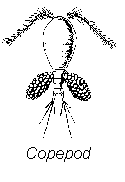 For
the benefit of those who may not have a background in invertebrate
zoology, I thought I would take a short journey through the world
of the freshwater wetland identifying some of the creatures which
I find so fascinating when dipping the wetlands of New England.
For
the benefit of those who may not have a background in invertebrate
zoology, I thought I would take a short journey through the world
of the freshwater wetland identifying some of the creatures which
I find so fascinating when dipping the wetlands of New England.
Most abundant in almost any dip are the copepods. There are too
many species to describe here but one observation I can make is
that they always seem to be pregnant (Seems that is what they
do best). That is probably why you always find them in such large
numbers.
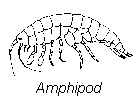 Another
frequent capture in the dipper is the amphipod sometimes referred
to as a side swimmer. Very often these inhabitants take on vivid
colorations of green and pink. They are very fast swimmers and
can make for real aggravation when trying to observe under the
scope.
Another
frequent capture in the dipper is the amphipod sometimes referred
to as a side swimmer. Very often these inhabitants take on vivid
colorations of green and pink. They are very fast swimmers and
can make for real aggravation when trying to observe under the
scope.
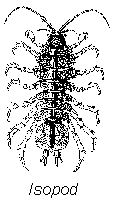 Isopods
are also found in great numbers in most of the same habitats as
mosquitoes. Many may know the terrestrial version which is very
often called a pill bug even though it is not an insect. (As a
kid I had a much more technical name...army tanks.)
Isopods
are also found in great numbers in most of the same habitats as
mosquitoes. Many may know the terrestrial version which is very
often called a pill bug even though it is not an insect. (As a
kid I had a much more technical name...army tanks.)
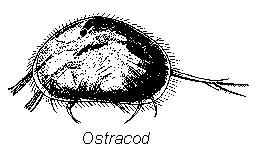 Among
the other more common crustaceans found in the New England wetlands
are the Ostracods, the Cochostracans, the Cladocerans (we all
know Daphnia - the water flea) and the Branchiopoda represented
by the fairy shrimp which is a common tropical fish food. Look
at these creatures under the scope and it looks as though these
tiny armored arthropods are held together with riveted plates.
Fascinating alien life right in your own back yard.
Among
the other more common crustaceans found in the New England wetlands
are the Ostracods, the Cochostracans, the Cladocerans (we all
know Daphnia - the water flea) and the Branchiopoda represented
by the fairy shrimp which is a common tropical fish food. Look
at these creatures under the scope and it looks as though these
tiny armored arthropods are held together with riveted plates.
Fascinating alien life right in your own back yard.
Of course the insect world is well represented in the wetlands
of New England. There are too many to fully discuss here so I
thought I would only consider those that are the most common.
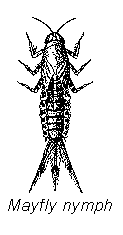 In
the spring just as the ice is disappearing from the inner reaches
of the northeastern wetland large numbers of the mayfly nymph
begin to fill the dipper with their rhythmically undulating abdominal
gills. Why they call these aquatic inhabitants mayflies is beyond
me for most are on the wing in April (maybe nobody told them!!!).
In
the spring just as the ice is disappearing from the inner reaches
of the northeastern wetland large numbers of the mayfly nymph
begin to fill the dipper with their rhythmically undulating abdominal
gills. Why they call these aquatic inhabitants mayflies is beyond
me for most are on the wing in April (maybe nobody told them!!!).
Along with the mayflies and in slightly less stagnant water is
the stonefly larvae which is more commonly found in the same habitats
as the dreaded blackfly larvae. (You have to be quicker than the
trout if you want to see one of these!)

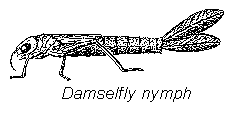 Less
commonly found but always a thrill when captured in the dipper
is the dragonfly and damselfly nymphs which we should develop
a strong bond with for these creatures share a common interest
in wiping out mosquito larvae. Though their ineffectiveness in
controling large numbers of mosquitoes is evident, their efforts
should be applauded. Of interest is the dragonfly's ability to
expell water from the rectum for rapid escape (never try this
at home without proper training).
Less
commonly found but always a thrill when captured in the dipper
is the dragonfly and damselfly nymphs which we should develop
a strong bond with for these creatures share a common interest
in wiping out mosquito larvae. Though their ineffectiveness in
controling large numbers of mosquitoes is evident, their efforts
should be applauded. Of interest is the dragonfly's ability to
expell water from the rectum for rapid escape (never try this
at home without proper training).
As mentioned above the caddisfly also shares the aquatic habitat
with the mosquito. I find the varied styles of case making intriguing
and wonder 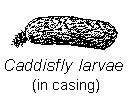 why
some species use pebbles while others use leaves. (Does one know
something the other doesn't or does the pebble siding company
do more advertising?)
why
some species use pebbles while others use leaves. (Does one know
something the other doesn't or does the pebble siding company
do more advertising?)
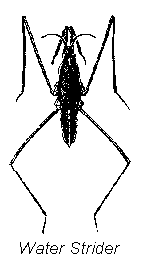 I
could go on forever describing the diving beetles, the whirligig
beetles, the backswimmers, the water striders ( I would love to
be able, as a mosquito control officer, to walk on water...life
would be so much simpler), the giant water bugs (sounds like a
class B horror flick...they bite by the way...just found that
out recently) and many, many more. One of my favorites is the
springtail which is sometimes called the snow bug in New England
because of the large numbers frequently found on snow during warm
winter days.
I
could go on forever describing the diving beetles, the whirligig
beetles, the backswimmers, the water striders ( I would love to
be able, as a mosquito control officer, to walk on water...life
would be so much simpler), the giant water bugs (sounds like a
class B horror flick...they bite by the way...just found that
out recently) and many, many more. One of my favorites is the
springtail which is sometimes called the snow bug in New England
because of the large numbers frequently found on snow during warm
winter days.
Lets not forget the annelids such as the horsehair worm and everyone's
favorite the leech (which brings out as much fear as "jaws"
in many - usually resulting in a hasty retreat out of the wetland).
The flatworms are well represented in the dipper by the laboratory
favorite planaria.
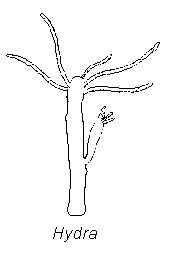 Finally
I recently found examples of freshwater sponges and hydras. That
made my day. I have read about freshwater examples of these but
had always thought they were going the same route as the freshwater
mussel. As a kid, I use to fish by the old mill site in Walpole,
Massachusetts but spent most of my time investigating the mussel
beds down stream. Most of the mussels are gone now but I can report
that I have seen more in recent years which I hope is a sign of
recovery.
Finally
I recently found examples of freshwater sponges and hydras. That
made my day. I have read about freshwater examples of these but
had always thought they were going the same route as the freshwater
mussel. As a kid, I use to fish by the old mill site in Walpole,
Massachusetts but spent most of my time investigating the mussel
beds down stream. Most of the mussels are gone now but I can report
that I have seen more in recent years which I hope is a sign of
recovery.
There are so many fascinating creatures inhabiting the New England
wetlands, so many that I could never mention them all but the
next time you go out dipping take a little closer look at what
else is out there. Many times I will take my trusty, cleaned-out
peanut butter jar (my hi-tech, low-cost laboratory collecting
device) with me and bring back some of these inhabitants to show
anyone interested. You would be surprised how interested the commoner
will be. I have often brought samples along with me when visiting
the various school systems across Norfolk County. The students
in the elementary schools are especially impressed. Seeing them
eyeball to eyeball with these creatures brings back the memories
I have of sliding across the ice in my back yard pond following
the travels of my newest find under the frozen world of the New
England winter.
by John J. Smith, Superintendent
Norfolk County Mosquito Control Project
Norwood, Mass.
 click button to return home
click button to return home
 I
have often corrected people when they would say that there are
no mosquitoes around in the middle of winter when in fact there
are millions of mosquitoes around they just happen to be in the
egg stage. As a kid I always thought that the invertebrates were
destroyed by the freezing temperatures of winter and always curious
as to how they recovered the next spring. My answer awaited me
on the first semi-warm winter day when the sun would heat the
sheltered areas around my house and I would observe house flies
and queen wasps lethargically sunning themselves. I would turn
over rocks in mid February and find a myriad of invertebrates
busily performing the art of survival under the most inhospitable
conditions. I think this is when my interest in invertebrates
began, resulting in many years of observations while involved
with research at the University of Connecticut and post-grad at
Northeastern University. The same intense interest continues while
sampling mosquito larvae during preparations for larval control
operations in Norfolk County, Massachusetts.
I
have often corrected people when they would say that there are
no mosquitoes around in the middle of winter when in fact there
are millions of mosquitoes around they just happen to be in the
egg stage. As a kid I always thought that the invertebrates were
destroyed by the freezing temperatures of winter and always curious
as to how they recovered the next spring. My answer awaited me
on the first semi-warm winter day when the sun would heat the
sheltered areas around my house and I would observe house flies
and queen wasps lethargically sunning themselves. I would turn
over rocks in mid February and find a myriad of invertebrates
busily performing the art of survival under the most inhospitable
conditions. I think this is when my interest in invertebrates
began, resulting in many years of observations while involved
with research at the University of Connecticut and post-grad at
Northeastern University. The same intense interest continues while
sampling mosquito larvae during preparations for larval control
operations in Norfolk County, Massachusetts.
 For
the benefit of those who may not have a background in invertebrate
zoology, I thought I would take a short journey through the world
of the freshwater wetland identifying some of the creatures which
I find so fascinating when dipping the wetlands of New England.
For
the benefit of those who may not have a background in invertebrate
zoology, I thought I would take a short journey through the world
of the freshwater wetland identifying some of the creatures which
I find so fascinating when dipping the wetlands of New England.
 Another
frequent capture in the dipper is the amphipod sometimes referred
to as a side swimmer. Very often these inhabitants take on vivid
colorations of green and pink. They are very fast swimmers and
can make for real aggravation when trying to observe under the
scope.
Another
frequent capture in the dipper is the amphipod sometimes referred
to as a side swimmer. Very often these inhabitants take on vivid
colorations of green and pink. They are very fast swimmers and
can make for real aggravation when trying to observe under the
scope.
 Isopods
are also found in great numbers in most of the same habitats as
mosquitoes. Many may know the terrestrial version which is very
often called a pill bug even though it is not an insect. (As a
kid I had a much more technical name...army tanks.)
Isopods
are also found in great numbers in most of the same habitats as
mosquitoes. Many may know the terrestrial version which is very
often called a pill bug even though it is not an insect. (As a
kid I had a much more technical name...army tanks.)
 Among
the other more common crustaceans found in the New England wetlands
are the Ostracods, the Cochostracans, the Cladocerans (we all
know Daphnia - the water flea) and the Branchiopoda represented
by the fairy shrimp which is a common tropical fish food. Look
at these creatures under the scope and it looks as though these
tiny armored arthropods are held together with riveted plates.
Fascinating alien life right in your own back yard.
Among
the other more common crustaceans found in the New England wetlands
are the Ostracods, the Cochostracans, the Cladocerans (we all
know Daphnia - the water flea) and the Branchiopoda represented
by the fairy shrimp which is a common tropical fish food. Look
at these creatures under the scope and it looks as though these
tiny armored arthropods are held together with riveted plates.
Fascinating alien life right in your own back yard.
 In
the spring just as the ice is disappearing from the inner reaches
of the northeastern wetland large numbers of the mayfly nymph
begin to fill the dipper with their rhythmically undulating abdominal
gills. Why they call these aquatic inhabitants mayflies is beyond
me for most are on the wing in April (maybe nobody told them!!!).
In
the spring just as the ice is disappearing from the inner reaches
of the northeastern wetland large numbers of the mayfly nymph
begin to fill the dipper with their rhythmically undulating abdominal
gills. Why they call these aquatic inhabitants mayflies is beyond
me for most are on the wing in April (maybe nobody told them!!!).

 Less
commonly found but always a thrill when captured in the dipper
is the dragonfly and damselfly nymphs which we should develop
a strong bond with for these creatures share a common interest
in wiping out mosquito larvae. Though their ineffectiveness in
controling large numbers of mosquitoes is evident, their efforts
should be applauded. Of interest is the dragonfly's ability to
expell water from the rectum for rapid escape (never try this
at home without proper training).
Less
commonly found but always a thrill when captured in the dipper
is the dragonfly and damselfly nymphs which we should develop
a strong bond with for these creatures share a common interest
in wiping out mosquito larvae. Though their ineffectiveness in
controling large numbers of mosquitoes is evident, their efforts
should be applauded. Of interest is the dragonfly's ability to
expell water from the rectum for rapid escape (never try this
at home without proper training).
 why
some species use pebbles while others use leaves. (Does one know
something the other doesn't or does the pebble siding company
do more advertising?)
why
some species use pebbles while others use leaves. (Does one know
something the other doesn't or does the pebble siding company
do more advertising?)
 I
could go on forever describing the diving beetles, the whirligig
beetles, the backswimmers, the water striders ( I would love to
be able, as a mosquito control officer, to walk on water...life
would be so much simpler), the giant water bugs (sounds like a
class B horror flick...they bite by the way...just found that
out recently) and many, many more. One of my favorites is the
springtail which is sometimes called the snow bug in New England
because of the large numbers frequently found on snow during warm
winter days.
I
could go on forever describing the diving beetles, the whirligig
beetles, the backswimmers, the water striders ( I would love to
be able, as a mosquito control officer, to walk on water...life
would be so much simpler), the giant water bugs (sounds like a
class B horror flick...they bite by the way...just found that
out recently) and many, many more. One of my favorites is the
springtail which is sometimes called the snow bug in New England
because of the large numbers frequently found on snow during warm
winter days.
 Finally
I recently found examples of freshwater sponges and hydras. That
made my day. I have read about freshwater examples of these but
had always thought they were going the same route as the freshwater
mussel. As a kid, I use to fish by the old mill site in Walpole,
Massachusetts but spent most of my time investigating the mussel
beds down stream. Most of the mussels are gone now but I can report
that I have seen more in recent years which I hope is a sign of
recovery.
Finally
I recently found examples of freshwater sponges and hydras. That
made my day. I have read about freshwater examples of these but
had always thought they were going the same route as the freshwater
mussel. As a kid, I use to fish by the old mill site in Walpole,
Massachusetts but spent most of my time investigating the mussel
beds down stream. Most of the mussels are gone now but I can report
that I have seen more in recent years which I hope is a sign of
recovery.
